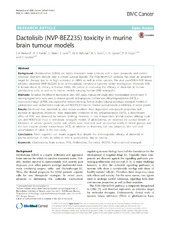| dc.description.abstract | Background: Glioblastomas (GBMs) are highly malignant brain tumours with a poor prognosis, and current cytotoxic regimens provide only a limited survival benefit. The PI3K/Akt/mTOR pathway has been an attractive target for therapy due to its high activation in GBMs as well as other cancers. The dual pan-PI3K/mTOR kinase inhibitor dactolisib (NVP-BEZ235) is an anti-neoplastic compound currently under investigation. However, little is known about its efficacy in human GBMs. We aimed at evaluating the efficacy of dactolisib in human glioblastoma cells, as well as in murine models carrying human GBM xenografts. Methods: To assess the effect of dactolisib in vitro, MTS assay, manual cell count, BrdU incorporation and Annexin V staining experiments were used to observe growth and apoptosis. Furthermore, Akt phosphorylation (S473), a downstream target of PI3K, was explored by western blotting. Animal studies utilizing orthotopic xenograft models of glioblastoma were performed in nude rats and NOD/SCID mice to monitor survival benefit or inhibition of tumor growth. Results: We found that dactolisib in vitro shows excellent dose dependent anti-growth properties and increase in apoptosis. Moreover, dose dependent inhibition of Akt phosphorylation (S473), a downstream effect of PI3K, was observed by western blotting. However, in two independent animal studies utilizing nude rats and NOD/SCID mice in orthotopic xenograft models of glioblastoma, we observed no survival benefit or inhibition of tumour growth. Severe side effects were observed, such as elevated levels of blood glucose and the liver enzyme alanine transaminase (ALT), in addition to diarrhoea, hair loss (alopecia), skin rash and accumulation of saliva in the oral cavity. Conclusion: Taken together, our results suggest that despite the anti-neoplastic efficacy of dactolisib in glioma treatment in vitro, its utility in vivo is questionable due to toxicity. | en_US |

